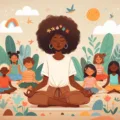Art therapy has become a popular method for improving mental health by encouraging creativity and self-expression. It is a therapeutic technique that combines the creative process of art-making with the skills of a trained therapist to improve and enhance the physical, mental, and emotional well-being of individuals of all ages. In this article, we will explore 15 art therapy activities and exercises that can be beneficial for both children and adults.
What is Art Therapy?
Art therapy is a form of psychotherapy that uses art media as its primary mode of communication. It’s particularly useful for individuals who find it hard to express their thoughts and feelings verbally. This therapy can help people explore emotions, develop self-awareness, cope with stress, boost self-esteem, and work on social skills.
Benefits of Art Therapy
- Reduces anxiety and stress
- Enhances cognitive abilities
- Improves motor skills
- Encourages emotional growth
- Fosters creativity and innovation
Art Therapy Activities for Children
- Clay Sculpting: Working with clay allows children to express themselves through the sense of touch and build fine motor skills.
- Collage Making: Creating a collage from various materials can help children articulate feelings and tell stories without words.
- Finger Painting: This tactile activity encourages emotional release and self-expression.
- Mandala Coloring: Coloring mandalas can be a meditative exercise that promotes relaxation and focus.
- Mask Creation: Making masks can help children explore different aspects of their personality and emotions.
Art Therapy Exercises for Adults
- Journaling with Art: Keeping an art journal where one doodles, draws, or pastes images can be a reflective practice.
- Self-Portrait: Creating a self-portrait can be a powerful way to reflect on self-image and identity.
- Abstract Art: Making abstract art allows for emotional expression without the need for a concrete subject.
- Photography: Using photography to capture moments can be therapeutic and help with mindfulness.
- Sculpture: Building sculptures can be a way to confront and work through complex feelings.
Group Art Therapy Activities
Art therapy can also be done in groups, which can help build community and support among participants. Activities like group murals or collaborative storytelling through art can enhance social skills and provide a sense of belonging.
FAQ
Who can benefit from art therapy?
Individuals of all ages can benefit from art therapy, including those facing mental health challenges, emotional upheavals, learning disabilities, neurological conditions, and physical illnesses.
Do you need to be skilled at art to participate in art therapy?
No, art therapy is not about the end product but the process of creation. People of all artistic skill levels can participate.
How does art therapy work?
Art therapy works by allowing individuals to express themselves in a creative and nonverbal way, which can help in processing complex feelings and reducing distress.
Can art therapy be practiced at home?
Yes, while guided by a professional therapist is ideal, many art therapy activities can be practiced at home for personal growth and stress relief.
How often should you engage in art therapy activities?
The frequency can vary based on personal needs and goals. Some may benefit from daily practice, while others might find weekly sessions to be sufficient.









